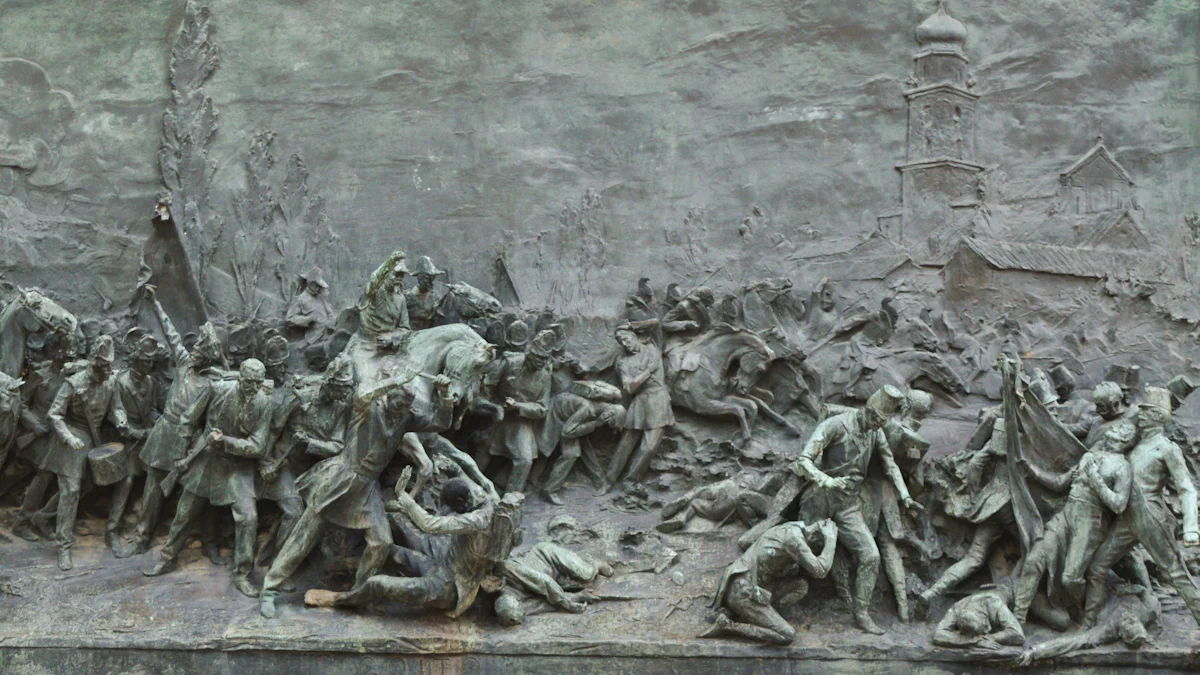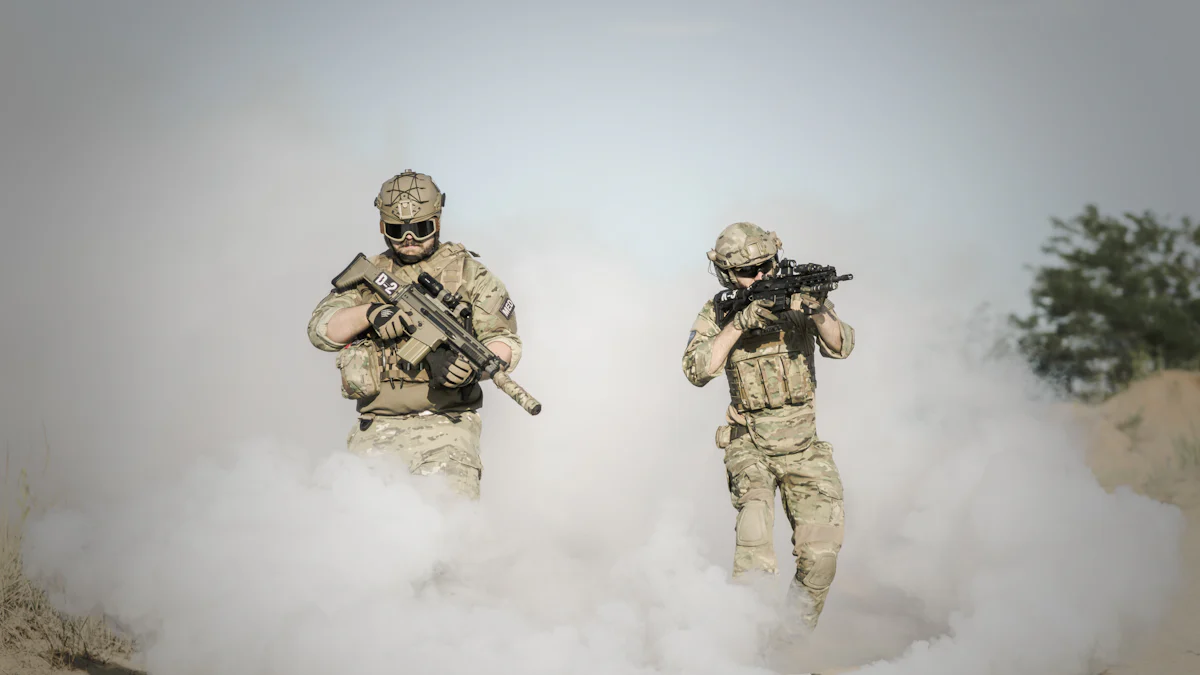Warfare: The Definitive Visual History

Warfare has profoundly influenced the course of human history for over 5,000 years. Wars have claimed the lives of more than 37 million people since 1800, with conflicts accounting for approximately 1 in every 700 deaths. The number of fatalities can fluctuate significantly each year; for instance, in 2005, fewer than 20,000 individuals perished in armed conflicts. However, during the two World Wars, millions lost their lives annually. A visual history of battles provides a distinctive perspective on warfare and its consequences. This method employs imagery to vividly depict historical events, making complex topics more accessible and engaging.
Ancient Warfare

Early Conflicts
Mesopotamian Wars
Mesopotamia witnessed some of the earliest known conflicts. City-states like Ur and Lagash often clashed over resources. These battles shaped early military strategies. Mesopotamians used infantry formations and chariots. Bronze weapons played a crucial role in their warfare.
Egyptian Military Campaigns
The New Kingdom of Egypt engaged in significant military campaigns. Pharaohs expanded territories through strategic battles. The conflict with the Hittite Empire marked a historic event. This battle involved over 5,000 chariots, making it the largest chariot battle recorded. Egyptian forces demonstrated advanced tactics and organization.
Classical Era
Greek and Persian Wars
The Greek and Persian Wars defined classical warfare. Greek city-states united against the Persian Empire. Battles like Marathon and Thermopylae became legendary. The phalanx formation proved effective for the Greeks. This tactic influenced future military strategies.
Roman Conquests
Roman conquests expanded the empire across Europe and beyond. The Romans adopted the Greek phalanx and enhanced it. Roman legions displayed discipline and innovation. Their engineering skills supported military campaigns. Roads and fortifications facilitated rapid troop movements.
Medieval Warfare
Feudal Conflicts
The Crusades
The Crusades began in 1095. European Christians aimed to reclaim the Holy Land. These religious wars spanned nearly two centuries. Crusader states faced constant raiding warfare. Exhaustion and overwhelming numbers led to their decline. The Crusades left a lasting impact on Europe and the Middle East.
Hundred Years' War
The Hundred Years' War lasted from 1337 to 1453. England and France engaged in a series of conflicts. This war saw significant battles like Agincourt and Crécy. English longbowmen played a crucial role in victories. The war ended with French success, altering European power dynamics.
Technological Advancements
Introduction of Gunpowder
Gunpowder changed medieval warfare. Invented in China, it spread to Europe by the 13th century. Cannons and firearms replaced traditional weapons. Gunpowder reduced the effectiveness of armored knights. This innovation marked the beginning of modern warfare.
Siege Warfare
Siege warfare became a common strategy in medieval times. Armies surrounded castles and fortified cities. Siege engines like trebuchets and battering rams were used. Defenders relied on strong walls and moats for protection. Sieges could last months, testing the endurance of both sides.
Modern Warfare

World Wars
World War I
World War I began in 1914 and ended in 1918, marking a significant period in global history. The conflict involved major powers like the British, French, and German forces. The Battle of Mons in August 1914 marked the first major action of the British Expeditionary Force. The Allied forces faced the German Army in a fierce confrontation. The Battle of Amiens in 1918 saw the Allies attack successfully, causing large-scale German casualties. This battle demonstrated the effectiveness of coordinated Allied strategies.
The Battle of Ypres became another notable event during the war. The Allied forces faced severe challenges against the German Army. The use of chemical weapons marked a grim chapter in warfare history. The Financial Cost of World War I reached staggering amounts, with the Financial Cost in billions impacting economies worldwide. The war's end reshaped political landscapes and set the stage for future conflicts.
World War II
World War II, spanning from 1939 to 1945, remains the deadliest conflict in human history. The Allies invade Normandy on D-Day, marking a pivotal moment. The Battle of the Bulge represented Adolf Hitler halting Germany's last major offensive. The Allies secured victory despite harsh conditions. The Battle of Midway proved a turning point in the Pacific, with the U.S. Pacific Fleet defeating Japanese forces.
The Battle of Iwo Jima showcased the resilience of American troops. The capture of this strategic island facilitated further Allied advances. The Financial Cost of World War II reached unprecedented levels, with the Financial Cost in billions affecting global economies. The war's conclusion led to the establishment of the United Nations, aiming to prevent future conflicts.
American Wars
American Civil War
The American Civil War remains the deadliest conflict in American History. The war ended the practice of slavery and reshaped the nation's future. The Civil War Battles like Gettysburg and Antietam witnessed immense American casualties. The Civil War Statistics reveal the staggering loss of life and resources. The Financial Cost of the war reached billions, impacting the economy for years.
The American flags symbolized unity and perseverance during this tumultuous period. The Civil War Leaders like Abraham Lincoln and Robert E. Lee played crucial roles. The Civil War Casualties highlighted the war's devastating impact on families and communities. The American War Timeline marks this period as a turning point in the nation's history.
Spanish-American War
The Spanish-American War in 1898 marked a significant chapter in American History. The conflict resulted in American Military Intervention in Cuba, Puerto Rico, and the Philippines. The American flags flew high as the nation emerged victorious. The war's outcome expanded American influence overseas.
The Financial Cost of the Spanish-American War reached billions, affecting national budgets. The American War grave markers serve as reminders of the sacrifices made. The war's legacy continues to shape diplomatic relations and military strategies. The American Intervention during this period marked a shift in foreign policy.
Contemporary Warfare
Post-Cold War Conflicts
Gulf War
The Gulf War began in 1990 when Iraq invaded Kuwait. The invasion prompted a swift response from a U.S.-led coalition. The coalition included British, French, and other Allied forces. The conflict aimed to liberate Kuwait and protect oil resources. The Allies launched Operation Desert Storm in 1991. The operation involved extensive aerial bombing campaigns. Ground forces advanced rapidly, overwhelming the Iraqi Army. The Battle of Khafji marked the first major ground engagement. The coalition forces achieved victory within weeks. The Financial Cost of the Gulf War reached billions.
Iraq War
Operation Iraqi Freedom began in 2003. A U.S.-led coalition invaded Iraq to overthrow Saddam Hussein. The coalition included British and other Allied forces. The invasion faced resistance from Iraqi forces and militias. The Battle of Sadr City occurred on April 4, 2004. Mahdi militiamen constructed obstacles that halted American vehicles. The conflict lasted nearly a decade, causing significant casualties. The Financial Cost of the Iraq War reached billions. The war's impact on regional stability remains profound.
Technological Innovations
Cyber Warfare
Cyber warfare emerged as a new threat in contemporary conflicts. Nations developed advanced cyber capabilities for defense and offense. Cyber attacks targeted critical infrastructure and communication networks. The Financial Cost of cyber warfare reached billions annually. Governments invested heavily in cybersecurity measures. Cyber warfare influenced military strategies and national security policies.
Drone Warfare
Drone warfare revolutionized modern military operations. Unmanned aerial vehicles provided real-time surveillance and precision strikes. Drones reduced the risk to human pilots in combat zones. The Financial Cost of drone warfare reached billions. Drones played a crucial role in counterterrorism efforts. The use of drones raised ethical and legal concerns. Drone warfare continues to evolve with technological advancements.
Warfare has evolved significantly over millennia, shaping societies and altering global dynamics. The introduction of technologies such as drones and cyber weapons has transformed modern warfare. These innovations have raised ethical questions under just war theory. The rise of autonomous weapons challenges traditional principles. Critical technologies like AI and 3D printing continue to influence military strategies. Future trends in warfare may include further advancements in these areas. Ethical implications and legal frameworks will remain central to discussions. Societies must consider the impact of these changes on humanity and international relations.
See Also
Armored Vehicles: An Illustrated History
Visual History of the American Revolution
The Ultimate Guide to Visual Arts

